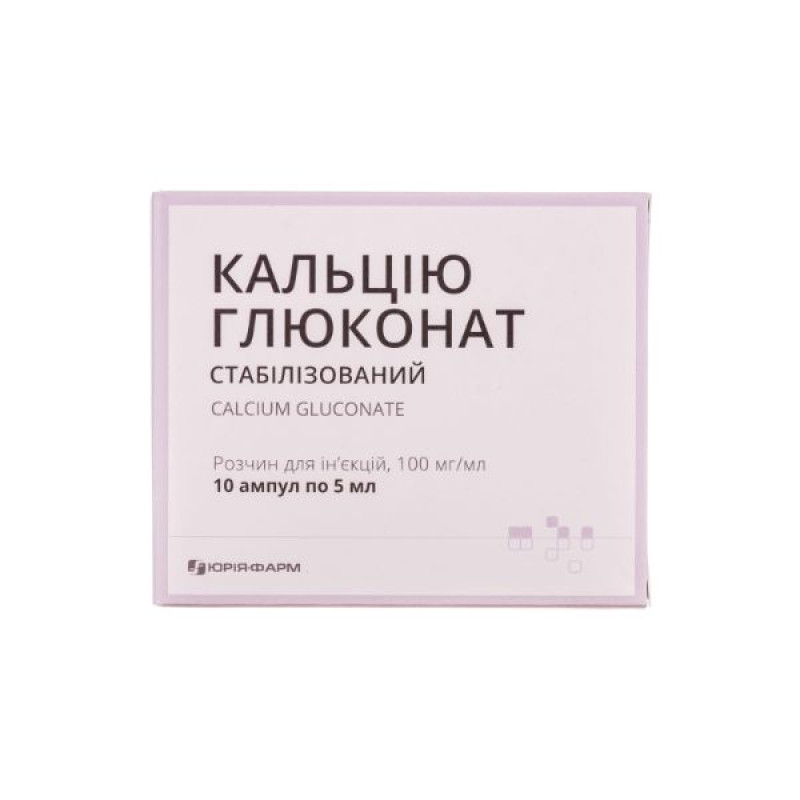Calcium gluconate solution for injection 10% ampoule 5 ml No. 10

Calcium gluconate is a drug that regulates metabolic processes, replenishes calcium deficiency in the body; has a hemostatic, anti-allergic effect, and reduces capillary permeability.
Indications for use
Insufficiency of parathyroid function, increased excretion of calcium from the body, as an adjuvant in allergic diseases (serum sickness, urticaria, angioedema) and allergic complications of drug therapy, to reduce vascular permeability in pathological processes of various genesis (exudative phase of the inflammatory process, hemorrhagic vasculitis, radiation sickness), parenchymal hepatitis, toxic liver lesions, nephritis, eclampsia, hyperkalemia, hyperkalemic form of paroxysmal myoplegia, skin diseases (itching of the skin, eczema, psoriasis), as a hemostatic agent, as an antidote in poisoning with magnesium salts, oxalic acid or its soluble salts.
Warehouse
1 ml of solution contains 95.5 mg of calcium gluconate (1 ml of the drug contains 8.95 mg of total calcium (Ca2+), which in terms of the theoretical content of calcium gluconate is equivalent to 100 mg/ml); excipients: calcium saccharate, water for injection.Contraindication
Hypersensitivity to the components of the drug.
Tendency to thrombosis.
Hypercalcemia.
Severe hypercalciuria.
Severe atherosclerosis.
Increased blood clotting.
Severe renal failure.
Sarcoidosis.
Concomitant use with cardiac glycosides, ceftriaxone.
Method of application
Adults and children over 14 years of age are administered 5–10 ml of a 10% solution once a day, depending on the nature of the disease and the patient's condition - daily, every other day or every 2 days.
For children, depending on age, 10% calcium gluconate solution is administered intravenously in the following doses: up to 6 months of age – 0.1–1 ml, 6–12 months of age – 1–1.5 ml, 1–3 years of age – 1.5–2 ml, 4–6 years of age – 2–2.5 ml, 7–14 years of age – 3–5 ml.
Application features
Calcium salts should be used with caution in patients with impaired kidney function and heart disease.
When used in patients receiving cardiac glycosides and/or diuretics, as well as during long-term treatment, the concentration of calcium and creatinine in the blood should be monitored, especially in children. In case of an increase in their concentration, the dose of the drug should be reduced or its use temporarily discontinued.
Pregnant women
The use of the drug during pregnancy or breastfeeding is possible provided that the benefit to the mother/risk to the fetus (child) is taken into account.
Children
Children under 14 years of age are not recommended to administer the drug intramuscularly due to the possibility of necrosis.
Drivers
There is no data on the negative impact of the drug on the reaction speed when driving or working with other mechanisms.
Overdose
Hypercalcemia may develop. Symptoms of hypercalcemia may include anorexia, nausea, vomiting, constipation, abdominal pain, muscle weakness, polydipsia, polyuria, mental disorders, nephrocalcinosis, nephrolithiasis, and in severe cases, cardiac arrhythmias and coma.
Side effects
Sometimes nausea, vomiting, diarrhea, bradycardia, a feeling of heat in the mouth, and later throughout the body, as well as skin changes may occur. These reactions quickly resolve on their own.
With rapid administration, nausea, vomiting, increased sweating, a feeling of heaviness in the head, syncope, general weakness, arterial hypotension, vasomotor collapse, sometimes fatal. Due to extravasal ingress of calcium solution, soft tissue calcification is possible.
Storage conditions
Store at a temperature not exceeding 25°C in the original packaging. Do not refrigerate. Keep out of the reach of children.
There are no reviews for this product.
There are no reviews for this product, be the first to leave your review.
No questions about this product, be the first and ask your question.
